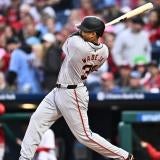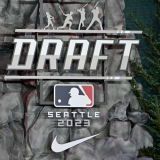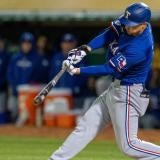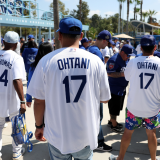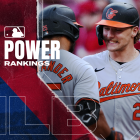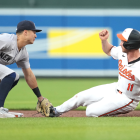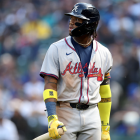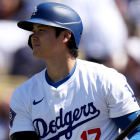
New York Yankees cloutsman Aaron Judge became the author of the ninth 60-home run season in the history of Major League Baseball on Tuesday night. Here's the company he now keeps -- i.e., the all-time single-season home run leaderboard:
- Barry Bonds, 2001: 73
- Mark McGwire, 1998: 70
- Sammy Sosa, 1998: 66
- Mark McGwire, 1999: 65
- Sammy Sosa, 2001: 64
- Sammy Sosa, 1999: 63
- Roger Maris, 1961: 61
- Babe Ruth, 1927; Aaron Judge, 2022: 60
Barring the wholly unforeseen he'll soon tie and surpass Roger Maris' American League record for home runs in a season and, heck, maybe even put some heat on the names at the very top of that list above. For now, though, let's savor the present and keep the focus on Judge's joining the 60-homer guild. We'll do that by putting Judge's season in a cursory statistical context.
Different eras across baseball history yield different conditions, and this affects everything -- home runs included. Hitting a homer in 1911 was wildly different from hitting one in 1930, just as hitting one in 1968 was nothing comparable to hitting one in 2000. Heck, even hitting one in 2017, when Judge's current teammate Giancarlo Stanton cracked 59 of them, was an easier feat than hitting one this year.
So with that in mind let's undertake a brief walking tour of Judge's season in comparison to those of his 60-homer peer group.
Judge is dominating his peer group like no one else
At this writing, Judge's 60-homer mark doesn't just lead the league, it lords over it. In second place is Kyle Schwarber of the Phillies with 40 home runs. If that margin holds up over the remainder of the regular season, then Judge will become the first slugger to lead the majors in home runs by a margin of 20 or more since Babe Ruth in 1928 paced the entire league by 23 homers. No player has led the majors by even 14 homers since Jimmie Foxx in 1933. Judge this season is dominating all comers at a level not glimpsed in almost a century.
Judge's 2022 season doesn't owe much to his home ballpark
Yankee Stadium is rightly known as an accommodating environment for sluggers. However, the tendencies of Judge's home ballpark in the Bronx haven't aided his home run tally all that much in 2022. First, he's a right-handed batter, and Yankee Stadium benefits left-handed home run hitters more than it does right-handed batters, thanks in large measure to that short porch in right field. There's also this:
- Judge's 2022 home runs at home: 30
- Judge's 2022 home runs on the road: 30
As well, Judge has actually been more productive on the road this season in terms of OPS (a 1.148 figure abroad versus 1.097 at home).
According to Statcast estimates, Judge this season if he'd played all his games at Yankee Stadium would've hit … 61 home runs instead of the 60 he actually had as of Wednesday morning. That's the same figure that, again per those Statcast estimates, he'd have if he played all his games in Dodger Stadium. He'd have more than 61 if he'd played his games in five non-Yankee ballparks.
All of that speaks to Judge's elite quality of contact. Frankly, no one today -- and probably ever -- hits the ball with such an ideal combination of force and angle. Judge at the moment leads the majors in average exit velocity off the bat, hard-hit percentage, and the rate of barrels (i.e., those balls that leave the bat with the perfect blend of exit velo and launch angle). More broadly, Statcast estimates his "expected" home run total for 2022 to be 0.8 homers shy of his actual total. Yes, that's 0.8 with a decimal.
Judge is facing velocity no other 60-homer hitter experienced
Higher pitch velocities make things tougher on hitters, which is why moundsmen work so assiduously to maximize their ability to throw the ball hard. Speaking of which, what batters like Judge are facing in 2022 is unexampled throughout baseball history. This season, the average major-league fastball checks in at 93.6 mph, which is the highest figure on record. The average slider this year comes in at 84.5 mph, which lags only 2021 and 2019 (84.6 in both cases). Back in 2002 -- the first year of standardized and publicly available velocity data -- MLB fastballs averaged 89.0 mph, and sliders were at 80.4 mph. Given that sharp trendline and given that the other 60-homer seasons happened before 2002, it's safe to assume his peers faced nothing like the heat Judge faces on a daily basis. That goes double for Maris and Ruth.
As well, the percentage of sliders faced by today's hitters is at a record level -- 21.8 percent versus 12.1 percent in 2002. In Judge's case, he's seeing sliders -- sliders that are often thrown harder than many of the fastballs faced by prior generations -- more than a quarter of the time. The others on the list above can't come close to that.
Judge is also facing more pitchers
It's long been known that increasing familiarity between batter and pitcher accrues to the benefit of the batter. The more times a batter sees a given pitcher, the better he's likely to fare. On this front, Judge stands alone in his lack of familiarity. Regard the players on our list ranked by the number of different pitchers seen during the seasons of note:
- Judge, 2022: 244 different pitchers faced (and counting)
- Sosa, 1999: 215 different pitchers faced
- Sosa, 2001: 213 different pitchers faced
- Sosa, 1998: 211 different pitchers faced
- McGwire, 1998; Bonds, 2001: 201 different pitchers faced
- McGwire, 1999: 198 different pitchers faced
- Maris, 1961: 101 different pitchers faced
- Ruth, 1927: 64 different pitchers faced
Judge has seen the most, and it's not a close race.
These days, teams use more pitchers per game than they ever have. Starters have their workloads limited so as to avoid, when possible, facing the opposing lineup for the third time in a given game or working on a high pitch count, which is when batters seize a big advantage. Rather than picking meat off the bones of a tiring starter, they face a sequence of hard-throwing relievers who tend to work no more than a frame at a time.
On an in-game level, today's hitters are benefitting from facing a fatigued pitcher far less often than in the past. Joe Sheehan in his very excellent baseball newsletter recently determined the percentage of plate appearances that come against starting pitchers working through the opposing order for a third time (or more) and relievers facing the order for a second time (or more) -- i.e., "tired" pitchers. Note how the percentage of such plate appearances has cratered over time, as has the percentage of hits that have come against tired pitchers:
| Year | Percent of total plate appearances vs. tired pitchers | Percent of total hits vs. tired pitchers |
|---|---|---|
1967 | 26.9% | 28.9% |
1982 | 27.6% | 29.4% |
1997 | 22.3% | 23.6% |
2012 | 20.0% | 20.9% |
2022 | 13.7% | 15.1% |
Here's another trend that's undeniably working against Judge in 2022 and, by extension, working for the other hitters on the Holy Ledger of Sixty. In related matters, teams in 2022 are using an average of 4.29 pitchers per game. In 2001, that figure was 3.63. In 1961 it was 2.44, and in 1927 it was 1.82.
Other considerations
But wait: That's not all! Finally, here's a hodgepodge of considerations that help put Judge's outputs this season in further context.
- He's the only member of the 60-homer club to play a premium position. This season, Judge has spent the comfortable majority of his 1,042 2/3 defensive innings in center field. That probably exacts a bit of a physical toll relative to what Sosa, McGwire, Bonds, Maris, and Ruth endured. Judge won't be in center moving forward, what with the activation of Harrison Bader, but he'll still wind up as a primary center fielder for the season.
- Unlike Ruth, Judge didn't benefit from playing against artificially limited -- i.e., all white -- competition.
- Unlike Maris, Judge didn't benefit from pitching staffs thinned out by expansion. All staffs were affected by the expansion draft, and Maris racked up 13 of his 61 home runs against the expansion Angels and Senators.
- McGwire, Sosa, and Bonds all profited from facing a league pool of pitching that was still compromised by dual rounds of expansion in 1993 and 1998. Some of course will point to the use of PEDs during that era as having boosted home run totals, but that's harder to quantify than the effects of double expansion.
Given the fact that Judge has -- urgent bulletin -- 60 home runs and has a very real shot at the Triple Crown, it's not exactly undaunted courage to say he's having a historically great 2022 season. In a fuller light, though, his work this year becomes even more astonishing. Now go forth in astonishment.








